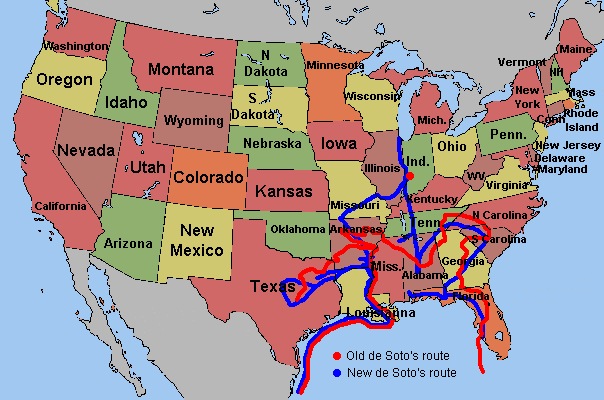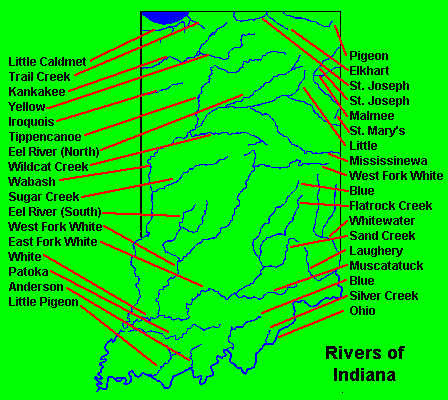A history and guide to my adopted home - Terre Haute, Indiana.
Important Note
I try to make these pages as accurate as I can but in August 2014, I received an email from Sean Ellis simply saying "Do yourself a huge favor" and giving a link to William Sanders' web page who lambasts Donald E. Sheppard's theories.
Since reading that page, and several others, it appears that Sheppard's theories about the journey Hernando de Soto are not widely accepted and that I was mistaken in adding the information to my own site.
Websites
Pages from Donald Sheppard
Spanish Exploration and Conquest of Native America
Sites Criticizing Donald Sheppard
General
American Beginnings: 1492 - 1690
True Relation of the Vicissitudes that Attended the Governor Hernando De Soto
Original Text from April 2002
Please remember when reading the following that the theories of Donald Sheppard are entirely his own and are not widely accepted. Rather than delete all the information on this page I have decided to keep it out of interest, but please remember, this is not historically accurate.
The earliest white explorers of Indiana were the expeditions led by the Spaniard, Hernando de Soto and later, the Frenchman, la Salle.
It was generally supposed that de Soto only traveled as far north as northern Tennessee, but recent research by Donald E. Sheppard and others have thrown doubt on this. They believe that de Soto and his men got as far north as Lake Michigan. Assuming that this is the case, I've drawn heavily on the site to produce the material for this page.

de Soto's routes
The traditional supposed route of de Soto is in red, the new supposed route is in blue.
For details of de Soto's journey through Indiana see Donald Sheppard's site.
De Soto landed in Florida on 25th May 1539. After spending a couple of weeks setting up camp he and his approximately 500 men started their historic trek northwards. They reached and crossed the Ohio River into Indiana, near the point of the present day Evansville, on 8th June 1541. On 24th June they'd reached the site of present day Vincennes. On 29th June 1541 they reached the town of Pacaha, on the site of present day Terre Haute. Pacaha was also the name of the chief of the place.
The following passages are taken from Donald Sheppard's site :-
Chief Casqui and his people had escorted de Soto from Vincennes to Terre Haute, improving the bridge at Busseron Creek along the way between cities on unfriendly terms. De Soto sent word to Pacaha that he was coming with Chief Casqui and expected Pacaha to be there when they arrived. Pacaha fled, instead, "with all his people out the other side of town. The governor immediately entered and together with the men of horse charged ahead where the Indians were fleeing; and at another town situated a quarter of a league (half a mile) from that place captured many Indians. And as the horsemen captured them they delivered them over to the Indians of Casqui, who, being their enemies, carefully and with great pleasure took them to the town where the Christians were; and the greatest sorrow they had was in not having permission to kill them."
The town of Pacaha was described as being one of the best since leaving Florida, two years before.
Donald Sheppard continues :-
"Many pelts of deer, cat, and bear were found in the town..." which were used to make clothing and shoes for the army. Heavy buffalo skins were likewise used to make armor for the horses.
"On Wednesday, June 19th (1541), [the 29th ?] the governor entered Pacaha ("...we saw the town on a plain, well palisaded and with a moat of water around it, dug by hand"). He lodged in the town where the chief lived, which was very large, enclosed, and furnished with towers (like a frontier cavalry fort); and in the towers and stockade many loopholes (to shoot arrows through). An abundance of old and new corn was found in the town and fields... large towns (spaced) at a league and half a league (2.6 to 1.3 miles) were found, all enclosed. Where the governor lodged there was a large marsh which came near to the enclosure and entered through a ditch round about the town so that but little of the town remained to enclose. A channel had been made from the marsh to the large (Wabash) river through which fish entered..."
"Another eyewitness says, "The town was very good and very esteemed in those parts... well palisaded with towers on the walls and with a ditch around most if it, filled with water which enters through an irrigation ditch that flows from the river.""
The village had 500 large and good houses and was on a site somewhat higher and more elevated than its surroundings (the French named "Terre Haute;" meaning: "high ground"). The Indians had made almost an island of it with a ditch... 50 paces wide, all made by hand. It was full of water from the river... which flowed 3 leagues (7 miles) above the village... The moat surrounded three sides of the village, the work not yet being complete. The fourth side was enclosed by a very strong wall made of thick logs set in the ground... This great moat and canal were filled with fish from the river..."
Terre Haute is drained by man-made canals; most old, some very old. The Spaniards described the one we call Thompson Ditch, which was given that name in 1886 when the State of Indiana straightened it. It drains the city's south side into Honey Creek and the Wabash River, 7 miles from its head at a beautiful man-made pond. "That pond had many very good fish of differnt kinds..." Another eye-witness confirms that location "... Indians in canoes discovered where the Chief of Pacaha was - on an islet between two arms of the river (the Wabash)... there were 5,000 souls on that islet..." but when detected "...fled in great haste to the other side of the river... swimming, where many people were drowned, principally women and children... we captured many Indians - men and women - and a quantity of clothing which the Indians had on wooden rafts... (several of those rafts) went floating downstream and the Indians of Casqui filled their canoes (then headed downstream for home without Desoto's consent)... On that account the governor was indignant at Casqui and immediately returned to Pacaha (village) two leagues (five miles) away..."
The island where Pacaha sought refuge in the Wabash River was drawn on the Illinois Township Survey of 1848; five miles west (on Hulman Road) of the man-made pond at the head of Thompson Ditch. Pacaha's village fronted that pond's northeast side between the ponds arms on the bluff near today's airport; well above the villages on the plain where Terre Haute is today. The northeast side of the village was walled but gated, allowing Pacaha's escape when the Spaniards came in from the river on Hulman Road.
If Donald Sheppard is right the Spaniards stayed at Pacaha for around 40 days. During this time de Soto sent a party of men north where they reached Lake Michigan. On 2nd August 1541 de Soto and his men were in Illinois.
The driving force behind the Spanish exploration was gold. De Soto was looking for El Dorado, the City of Gold. In his search for it he abused and was abused by the Indians. The French who came later were looking for trade. Most early explorers and traders followed the rivers. Here's a map of those in Indiana.

Indiana's Rivers
This page created 25th April 2002, last modified 11th November 2014